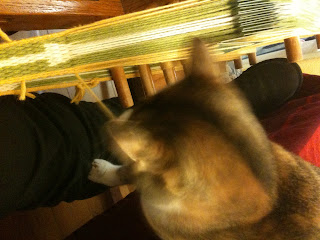I did not bother charting the pattern, because it is really simple. Instead I am writing exactly what I did. A while back I charted a dragon for someone who had never done double faced card weaving, and wound up giving them row by row directions for the first few rows. This helped her understand what to do with the chart. Charts are great for complex patterns, but I think charting very simple patterns is a waste of time, because it distracts you from letting the threads tell you what to do next.
On this piece, I chose to flip cards on their vertical axis rather than rolling my cards. I find this easiest, but you can substitute with rolling the cards twice, or changing the direction of the cards (see my previous post of double faced weave, if you want clarification). In the flipping method all but the selvedge (edge) cards move together as a group. I have no problem keeping track of my cards, but I am lazy, so I prefer to move them as a group. Selvedge cards roll in the same direction for long stretches, until you reverse their direction to remove your twist build up. Selvedge cards will keep your weaving flat, though they are not always necessary. I use the edge ground card (in this case green) to tell me which direction to go. Once it reaches the closest position (ground color in the 2 holes next to your body), it rotates forwards (away from you) until it gets to the furthest position (ground color in the 2 holes furthest away from your body). At that point it rotates backwards (towards you), until they are back in the closest position. You can always tell which cards you are making a pattern with, because they will have the design color in the holes that normally would have the ground color.
This piece is 20 cards wide. Two selvedge cards on each side are yellow, with the remaining 16 cards threaded half white, and half green. The cards are alternated S and Z across the band. I wove about an inch of basic ground before starting the lightning bolt. The white and yellow are wool yarn, the green is 75% wool/25% silk yarn.
With the ground color in the closest position, flip the center two cards on their vertical axis. Weave two more passes as if you were just weaving the ground. You should have the other color showing up in the middle of your band. You should be at furthest position, now flip one card on either side of the 2 middle cards, and weave two more passes. Aside from the starting color change, I use the cards with white in the holes to tell me where I am in the pattern. In this case all the furthest holes should be green except for the two center ones which have white in the furthest holes. Continue this process adding one card to each side, until you have only two cards of the ground remaining on either end. These two end ground cards will never flip in this pattern, and will tell you what the original position is. Flip all but the center four on their axis again (this will be the four cards cards on each end, after you skip the two on each end still in their original position), and weave two passes. You should now have an arrowhead with the beginning of a shaft.
I wove until I six floating stitches, then flipped the eight cards to the right to give me another line across the band, and wove two passes. Then I flipped eight cards from the left back to their original position. The line will now be on the right of the band. Once again I wove till I had six floats, then flipped four cards to the left of the four, and wove two passes. I flipped the four on the right back to their original position, so my line will be back in the center. I wove until I had six floats, then flipped four cards on either side, and wove two passes. Once again I have a line across the band. Then every two passes I flipped one card from the end back to the original position, until I had a solid green ground again.





On the selvedge cards, rather than reversing the direction I turn them, I flip them vertically. Now turning forwards has the opposite effect from which it had previously, and I still don't have to remember which way they're turning. (After all, the selvedge always turns forward. :)
ReplyDeleteargh. Just realized I misread; skipped the bit about doubleface. Me silly. Sorry.
DeleteNo worries. In general I flip on the axis, it makes things so much simpler. Still working on getting other folks to do that though. For some reason it seems to intimidate some people.
ReplyDelete